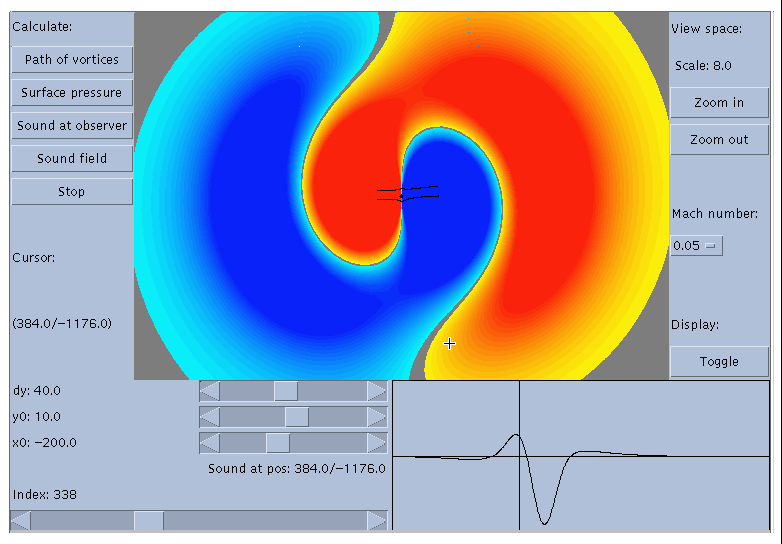|
Sound generation due to a vortex
pair near a circular cylinder
|
Back
|
Brief operating instructions:
- Select the initial position of the vortex pair
by the (x0,y0,dx)-sliders.
- Click "Path of vortices" to calculate the movement of the vortex pair.
- Click "Surface pressure" to compute the surface pressure and the
resulting forces.
The curves are shown in the lower right field.
"Toggle" switches between [forces vs time] and the
[surface pressure distribution at a certain time step].
The Index-slider is used to change the time step.
- Click inside the view space to select an observer position.
"Zoom in" and "Zoom out" can be used to adjust the scaling of the
display. The observer position is marked using a cross.
- Click "Sound at observer" to compute the sound-pressure history
at the observer position.
The [sound pressure vs time] is displayed
in the lower right field.
- Select a time step using the Index-slider. A vertical line indicates
the selected time in the [sound pressure vs time]-plot.
- Click "Sound field" to compute the sound pressure in the hole view space
at the selected time.
"Zoom in" and "Zoom out" can be used to rescale the view space.
When the scale factor is changed, "Sound field" has to be clicked again.
Yellow and red shades indicate a positive sound pressure.
Blue shades represent a negative value.
Snapshot of the applet running under JDK-appletviewer:

Technical info:
The vortex pair consists of two counter-rotating vortices of
equal strength.
No mean flow is present.
The path of the vortices is computed using the Biot-Savart law.
Two mirror vortices are used to fulfill the boundary condition at
the cylinder.
The unsteady Bernoulli equation is used to calculate the surface pressure
from the vortex data.
The method of Farassat is applied to compute the sound at an observer position
from the surface pressure data.
The selectable Mach number gives the ratio between the speed of the
vortex pair -- undisturbed, away from the cylinder -- and the speed of
sound used for the sound field calculations.
The path of the vortices is not affected by the Mach number.
Back

